
Chapter 19: The Animals
19.1 Evolution of Animals
The modern three-domain system places animals in:
Domain Eukarya
Kingdom Animalia
Within Eukarya, animals are placed in the supergroup Opisthokonta along with:
Fungi
Certain protists (notably the choanoflagellates)
Animals share important differences from other multicellular eukaryotes:
Unlike plants, animals are heterotrophs and must acquire nutrients from an external source.
Unlike fungi, animals ingest whole food and digest it internally.
Animals share the following characteristics:
Multicellular with specialized cells that form tissues and organs.
Possess nervous and muscular tissues that allow for mobility (locomotion).
Have a life cycle in which the adult is typically diploid.
Usually undergo sexual reproduction and produce an embryo that goes through developmental stages.
Heterotrophs that acquire food by ingestion, followed by digestion.
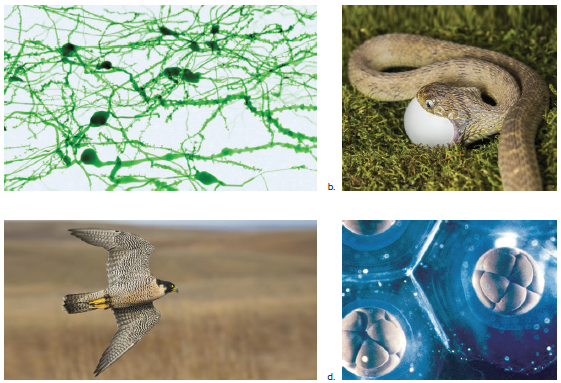
Ancestry of Animals
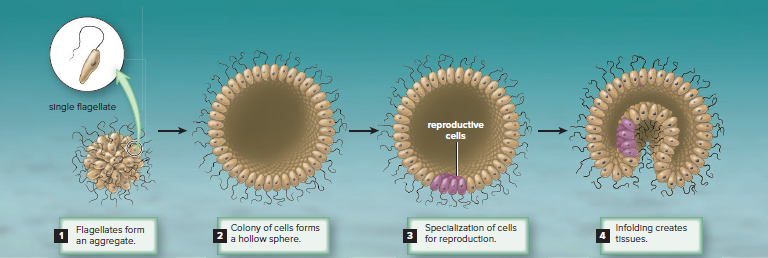
Plants and charophytes share a green algal ancestor.
Animals most likely evolved from a protozoan.
The colonial flagellate hypothesis suggests that animals descended from a hollow, spherical colony of flagellated cells.
Figure 19.2 shows the process of how this could have begun with a few flagellated cells forming an aggregate and then a larger number of cells forming a hollow sphere.
Individual cells within the colony would have become specialized for particular functions, such as reproduction.
Two tissue layers could have arisen by an infolding of certain cells into a hollow sphere.
Choanoflagellates most likely resemble the last single-celled ancestor of animals.
Molecular data tells us that choanoflagellates are the closest living protist relative of animals.
A choanoflagellate is a single cell, 3-10 μm in diameter, with a flagellum surrounded by a collar of 30-40 microvilli.
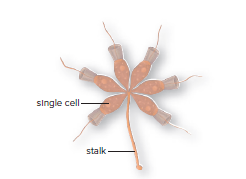
The Evolutionary Tree of Animals
The animal kingdom is divided into 35 phyla.
The majority of animals are invertebrates.
Invertebrates lack an internal skeleton of bone or cartilage.
Invertebrates evolved first and outnumber vertebrates.
The fossil record is sparse regarding the early evolution of animals due to simple invertebrates.
Systematists established the evolutionary history of animals based on molecular, developmental, and anatomical data.
Molecular comparisons establish evolutionary relationships.
DNA sequences of closely related organisms have more in common.
Advances in genomics and proteomics enhance the ability to distinguish between animal groups.
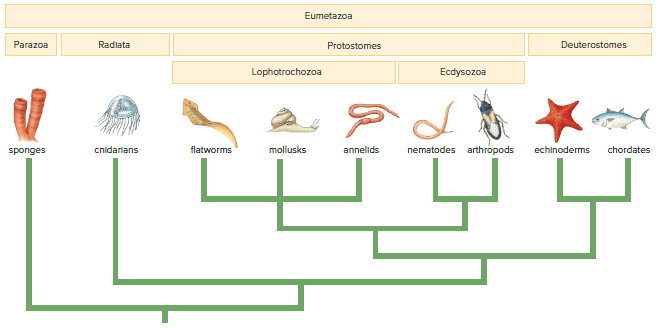
Evolutionary Trends
Animals differ in biological organization.
Sponges are multicellular but have no true tissues, classified as parazoans.
Cnidarians are eumetazoans with true tissues formed from two germ layers.
Other eumetazoans have three germ layers (ectoderm, mesoderm, endoderm).
Germ layers give rise to all other tissues and organs in an animal's body.
Animals differ in symmetry.
Sponges are asymmetrical.
Cnidarians have radial symmetry, while flatworms have bilateral symmetry.
Bilateral symmetry is accompanied by cephalization, localization of a brain, and specialized sensory organs at the anterior end of an animal.
Bilateral symmetry marked the evolution of animals that were able to exploit environmental resources in new ways through their more active lifestyles.
Animals are distinguished by the patterns of development as early embryo.
Protostomes have the blastopore become the mouth, while deuterostomes have it become the anus.
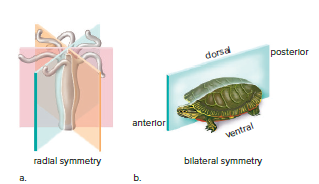
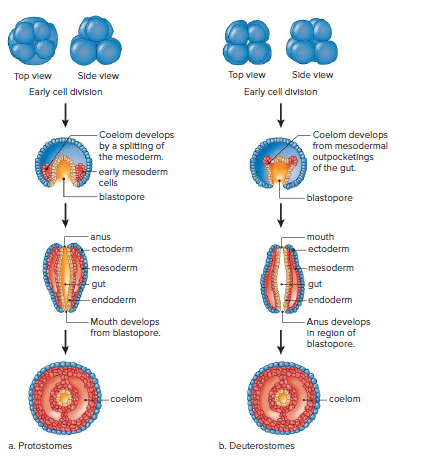
Molecular and developmental data suggest that protostomes are more closely related to each other than to deuterostomes.
Protostomes are divided into subgroups: lophotrochozoans and ecdysozoans.
Lophotrochozoans grow by adding mass to their existing body, while ecdysozoans grow by molting.
Some protostomes have no body cavity and are acoelomates, while others are coelomates.
Roundworms are pseudocoelomates, and their body cavity is incompletely lined by mesoderm.
In coelomate animals, mesentery supports the internal organs.
Animals can be nonsegmented or segmented.
Segmentation leads to the specialization of body parts.
19.2 Sponges and Cnidarians: The Early Animals
Sponges: Multicellularity
Sponges are aquatic, largely marine animals that vary greatly in size, shape, and color.
Sponges have a cellular level of organization and lack organized tissues.
Molecular data classify sponges as parazoans, which are located at the base of the evolutionary tree of animals.
The body wall of a sponge is lined internally with flagellated cells called collar cells or choanocytes.
The beating of the flagella produces water currents that flow through the pores into the central cavity and out through the osculum.
Sponges are sedentary filter feeders that filter their food from the water by means of a straining device.
Sponges can reproduce both asexually and sexually.
Some sponges have an endoskeleton composed of spicules, small, needle-shaped structures with one to six rays.
Most sponges have fibers of spongin, a modified form of collagen.
A bath sponge is the dried spongin skeleton from which all living tissue has been removed.

Cnidarians: True Tissues
Cnidarians are an ancient group of invertebrates with a rich fossil record.
They are radially symmetrical and capture their prey with a ring of tentacles that bear specialized stinging cells called cnidocytes.
Each cnidocyte has a capsule called a nematocyst, which contains a long, spirally coiled, hollow thread-like fiber.
Some nematocysts trap prey or predator, while others have spines that penetrate and inject paralyzing toxins before the prey is captured and drawn into the gastrovascular cavity.
Cnidarians have two germ layers during development (ectoderm and endoderm) and a tissue level of organization as adults.
They are classified as the first of the eumetazoans.
Two basic body forms are seen among cnidarians—the polyp and the medusa.
Cnidarians have been the source of medicines, particularly drugs that counter inflammation.
Coral reefs are comprised of cnidarians whose calcium exoskeletons serve as the foundation for the reef.
Corals form symbiotic relationships with photosynthetic protists called dinoflagellates.
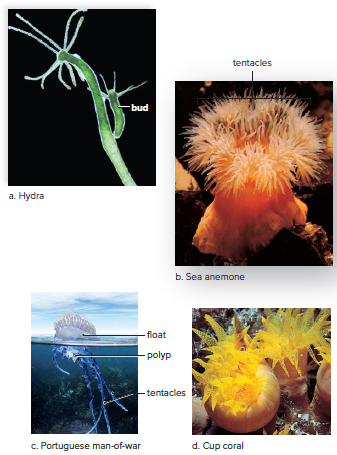
19.3 Flatworms, Molluscs, and Annelids: The Lophotrochozoans
Flatworms, molluscs, and annelids belong to the group of protostomes called lophotrochozoans.
The name "lophotrochozoans" is derived from a tentacle-like feeding structure called a lophophore and a larval stage called a trochophore.
Molecular analyses support the hypothesis that all lophotrochozoans share a common evolutionary ancestor.
Lophotrochozoans increase their body mass gradually without molting.
Lophotrochozoans are distinct from other protostomes, such as arthropods and nematodes.
Flatworms: Bilateral Symmetry
Flatworms (phylum Platyhelminthes) have bilateral symmetry and three germ layers.
They are acoelomates, meaning they lack a body cavity.
Free-living flatworms, called planarians, have a ladder-like nervous system, cephalization, and three muscle layers.
Planarians capture food by wrapping themselves around the prey, entangling it in slime, and pinning it down. They have a three-branched gastrovascular cavity where digestion occurs.
Planarians are hermaphrodites and practice cross-fertilization.
Parasitic flatworms belong to two classes: tapeworms and flukes.
Tapeworms are endoparasites of various vertebrates, including humans. They have a scolex and a series of reproductive units called proglottids.
Flukes are all endoparasites of various vertebrates and have an oral sucker and at least one other sucker used for attachment to the host. They are usually named for the organ they inhabit.
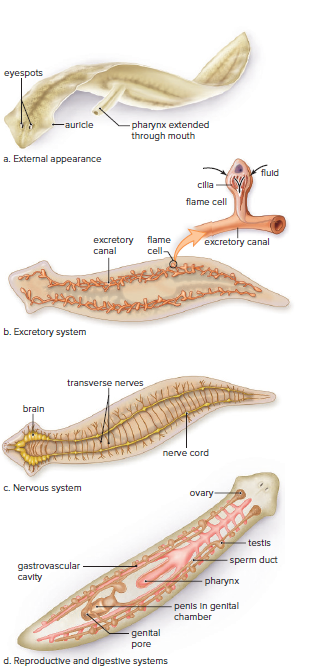
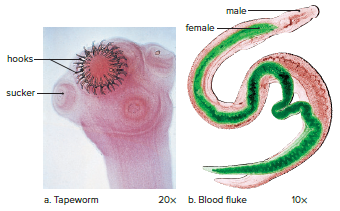
Molluscs
Molluscs: Coelomate organisms with a complete digestive tract.
The body is composed of at least three distinct parts:
Visceral mass: soft-bodied portion containing internal organs.
Foot: strong, muscular portion used for locomotion.
Mantle: membranous or sometimes muscular covering that envelops but does not completely enclose the visceral mass.
Mantle cavity: space between the two folds of the mantle.
The mantle may secrete an exoskeleton called a shell.
Radula: an organ that bears many rows of teeth and is used to obtain food.
Gastropods: the foot is ventrally flattened, and the animal moves by muscle contractions that pass along the foot.
Cephalopods: the foot has evolved into tentacles about the head.
Bivalves: are called bivalves because of the two parts of their shells.
Molluscs have economic importance as a source of food and pearls.
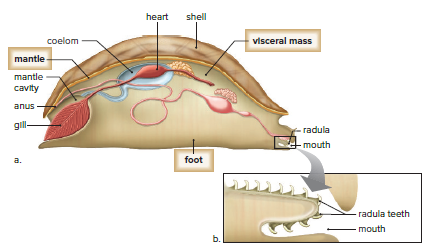
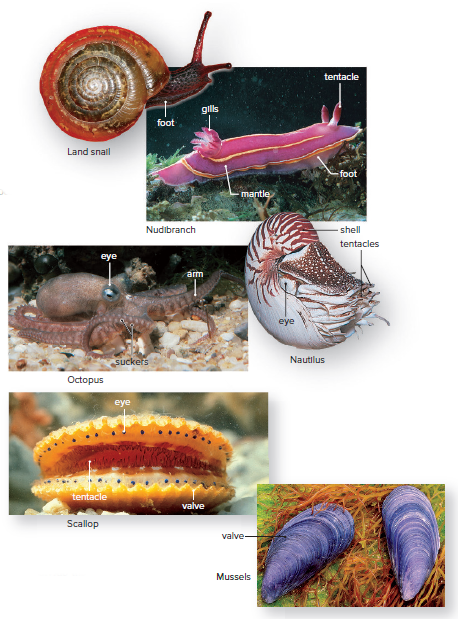
Annelids: Segmented Worms
Annelids are segmented worms with a well-developed coelom.
The coelom functions as a hydrostatic skeleton to facilitate movement.
Annelids have a complete digestive tract with specialized parts.
Annelids have an extensive closed circulatory system.
The nervous system consists of a brain, ventral nerve cord, and ganglia.
The excretory system consists of nephridia.
Most annelids are polychaetes.
Polychaetes have many setae that help them anchor or move.
Clam worms are predators with a well-defined head region.
Other polychaetes are sedentary tube worms.
Oligochaetes have few setae and include earthworms.
Earthworms are scavengers that live in the soil.
Leeches have no setae but have the same body plan as other annelids.
Leeches are fluid feeders that can penetrate the surface of an animal and suck in fluids.
Leeches secrete hirudin, a powerful anticoagulant.
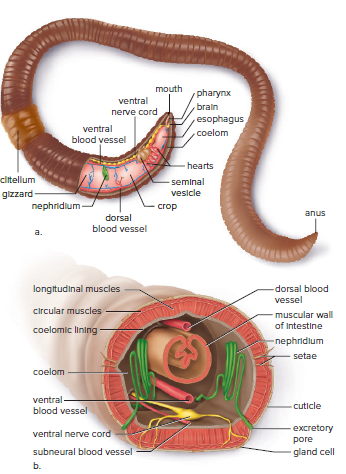
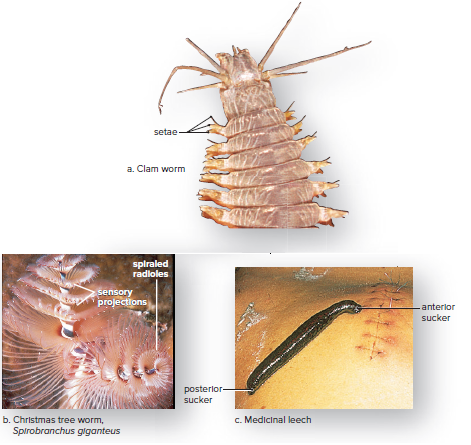
19.4 Roundworms and Arthropods: The Ecdysozoans
Ecdysozoans are invertebrate protostomes like lophotrochozoans.
They secrete a nonliving exoskeleton (cuticle) that must be shed for growth to proceed.
This process is called molting or ecdysis.
Ecdysozoans include roundworms (nematodes) and arthropods.
Roundworms: Pseudocoelomates
Roundworms (phylum Nematoda) are nonsegmented with a smooth outside body wall.
They possess a pseudocoelom that is incompletely lined with mesoderm, which supports muscle contraction and enhances flexibility.
The digestive tract is complete with both a mouth and an anus.
Roundworms are generally colorless, less than 5 cm long, and occur almost everywhere.
Many are free-living and feed on algae, fungi, microscopic animals, dead organisms, and plant juices, causing great agricultural damage.
Parasitic roundworms live anaerobically in every type of animal and many plants.
Several parasitic roundworms infect humans, including Ascaris lumbricoides, which produce over 200,000 eggs daily.
Trichinosis is a fairly serious human infection caused by the female trichina worm, which burrows into the wall of the host’s small intestine and deposits live larvae in the bloodstream that encyst skeletal muscles.
Elephantiasis is caused by a filarial worm that utilizes mosquitoes as a secondary host, and it can cause limbs to swell to an enormous size.
Pinworm and hookworm infections are more common in the United States, with hookworm being very debilitating as the worms attach to the intestinal wall and feed on blood.
Good hygiene, proper disposal of sewage, thorough cooking of meat, and regular deworming of pets usually protect people from parasitic roundworms.
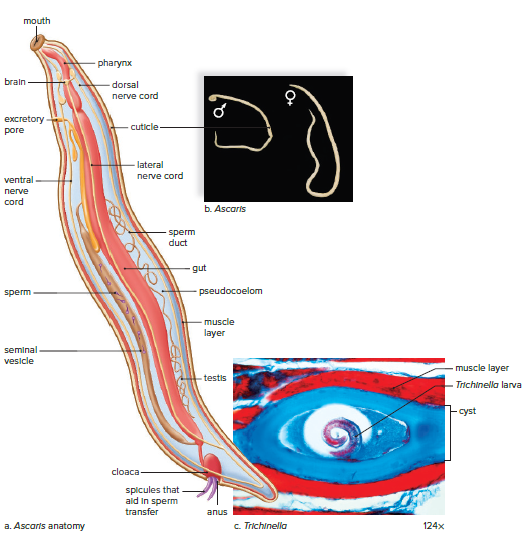
Arthropods: Jointed Appendages
Arthropods are a diverse phylum with over 1 million discovered species.
Many more species of arthropods, mostly insects, are yet to be discovered.
The success of arthropods can be attributed to six characteristics:
Jointed appendages that have become adapted to different means of locomotion, food gathering, and reproduction.
A rigid but jointed exoskeleton composed primarily of chitin that serves many functions, including protection, prevention of desiccation, attachment for muscles, and locomotion.
Segmentation, where the repeating units of the body are called segments, each with a pair of jointed appendages.
A well-developed nervous system with a brain, a ventral nerve cord, and various types of sense organs.
A variety of respiratory organs, including gills for marine forms, book lungs or air tubes called tracheae for terrestrial forms, and an open circulatory system with the dorsal heart pumping blood into various sinuses throughout the body.
Metamorphosis, where many arthropods undergo a change in form and physiology as the larva becomes an adult, allowing the larva to have a different lifestyle than the adult.
Crustaceans are a group of arthropods that include marine animals such as barnacles, shrimps, lobsters, and crabs.
Freshwater crustaceans include crayfish, and terrestrial ones include sowbugs or pillbugs.
Crustacean anatomy is diverse, but the head usually has a pair of compound eyes and five pairs of appendages.
The first two pairs of appendages are antennae and antennules, which have sensory functions, while the other three pairs are mouthparts used in feeding.
Lobsters have five pairs of walking legs, with the first one being a pinching claw, and gills situated above the walking legs.
The head and thorax are fused into a cephalothorax, covered by a nonsegmented carapace, while the abdominal segments have swimmerets and a fan-shaped tail to propel the lobster backward.
Crustaceans play a vital role in the food chain, with krill being a major source of food for baleen whales, sea birds, and seals.
Arachnids are a group of arthropods that include spiders, scorpions, ticks, mites, and harvestmen.
Spiders have a narrow waist that separates the cephalothorax from the abdomen and inject venom into their prey before digesting it externally.
Scorpions are among the oldest terrestrial arthropods and are nocturnal, spending most of the day hidden under a log or rock.
Ticks and mites are parasites that feed on vertebrates, with ticks sometimes transmitting diseases such as Rocky Mountain spotted fever and Lyme disease.
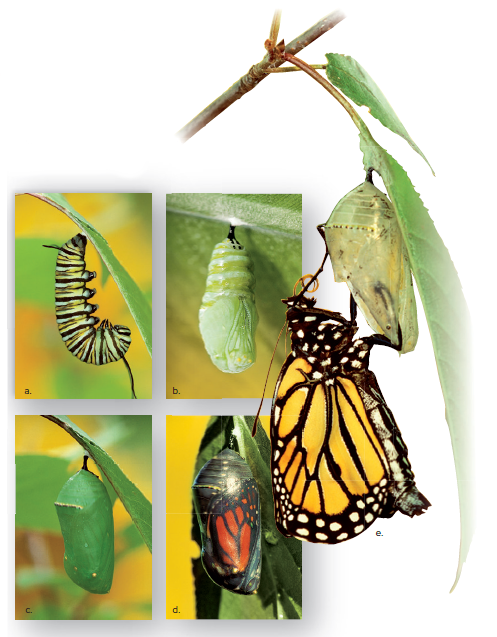
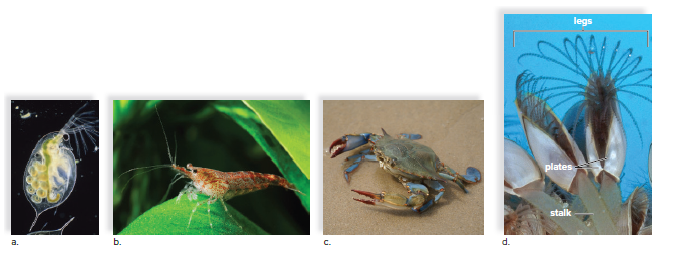
Horseshoe crabs are grouped with arachnids because of their first pair of appendages.
Horseshoe crabs have pedipalps and four pairs of walking legs.
Horseshoe crabs are valuable in medical science for their blood cells extract.
Millipedes have two pairs of legs on most segments and are herbivorous.
Centipedes have a pair of appendages on almost every segment and are carnivorous.
Insects are the largest group of arthropods and are adapted to an active life on land.
Insects have a head, thorax, and abdomen, with sensory antennae, compound eyes, and mouthparts adapted to their way of life.
The study of insects is called entomology.
Some insects show remarkable behavior adaptations, such as the social systems of bees, ants, termites, and other colonial insects.
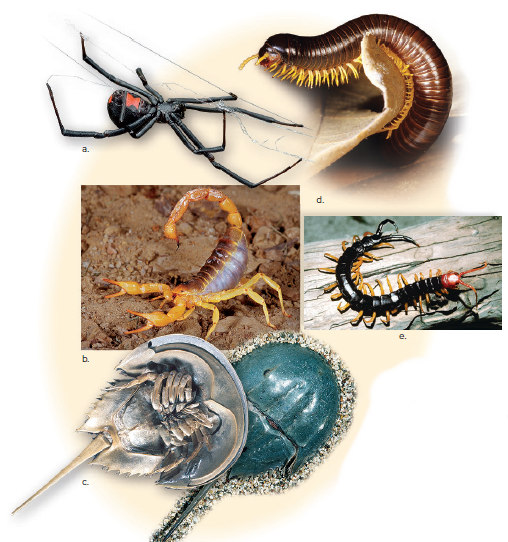
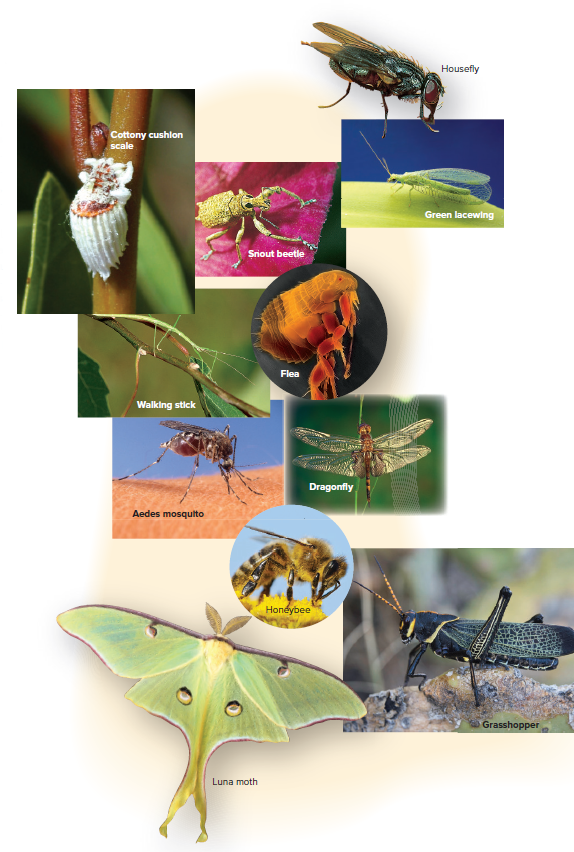
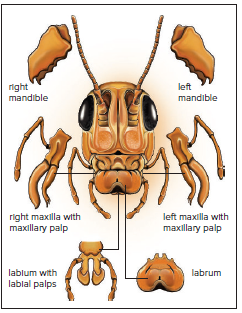
19.5 Echinoderms and Chordates: The Deuterostomes
Echinoderms
Echinoderms are invertebrate animals represented by sea stars and sea urchins.
Echinoderms are the animals most closely related to chordates, which include vertebrates such as humans.
Echinoderms are deuterostomes like chordates.
Echinoderms are often radially symmetrical, not bilaterally symmetrical.
The larva of an echinoderm is a free-swimming filter feeder with bilateral symmetry, but it metamorphoses into a radially symmetrical adult.
Adult echinoderms do not have a head, a brain, or a segmentation.
The nervous system of echinoderms consists of nerves in a ring around the mouth and extending outward radially.
Echinoderm locomotion depends on a water vascular system.
Echinoderms don't have complex respiratory, excretory, and circulatory systems.
Most echinoderms feed on organic matter in the sea or substratum, but sea stars prey upon crustaceans, molluscs, and other invertebrates.
Sea stars cause extensive economic loss because they consume oysters and clams before they can be harvested.
Echinoderms are important in many ways, such as being eaten by fishes and sea otters and being favored for embryological research by scientists.

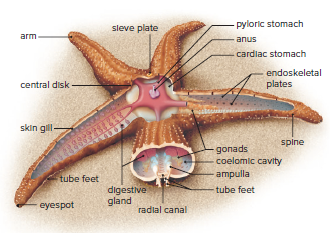
Chordates
The four characteristics of a chordate are:
A dorsal supporting rod called a notochord is located just below the nerve cord towards the back.
A dorsal tubular nerve cord that contains a canal filled with fluid.
Pharyngeal pouches that become functioning gills in some chordates and are modified for various purposes in terrestrial vertebrates.
A postanal tail that extends beyond the anus.
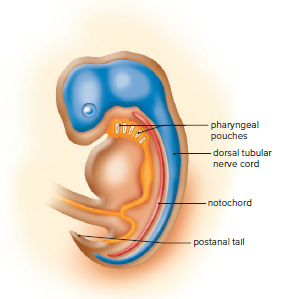
The Invertebrates Chordates
In some invertebrate chordates, the notochord is not replaced by the vertebral column.
Tunicates are ocean floor-dwelling chordates that look like thick-walled, squat sacs due to their tunic.
Tunicates are also called sea squirts because they squirt water from one of their siphons when disturbed.
Tunicate larvae are bilaterally symmetrical and have four chordate characteristics.
Metamorphosis produces sessile adults with numerous cilia that move water into the pharynx and out numerous gill slits, the only chordate characteristic that remains in the adult.
Lancelets are small marine chordates that look like small, two-edged surgical knives.
Lancelets are found in shallow water along most coasts and feed on microscopic particles filtered out of the constant stream of water that enters the mouth and exits through the gill slits.
Lancelets retain the four chordate characteristics as adults and have segmented muscles and a dorsal tubular nerve cord with periodic branches.
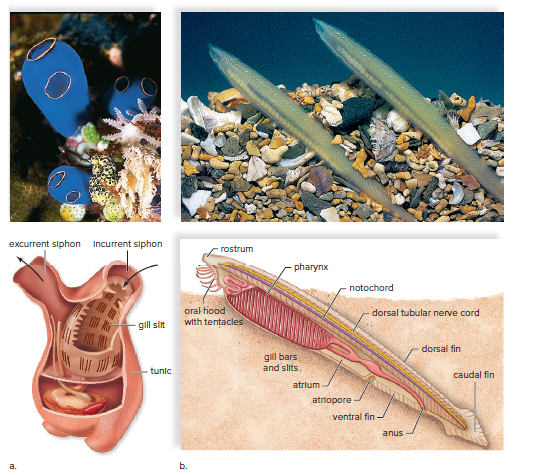
Evolutionary Trends Among the Chordates
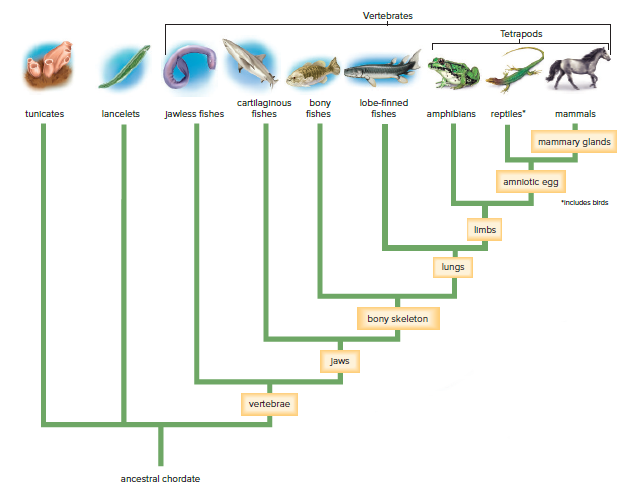
Figure 19.27 shows the evolutionary tree of chordates and the animal groups discussed in the chapter.
Each animal group has at least one main evolutionary trend that distinguishes it from the preceding group.
Tunicates and lancelets are invertebrate chordates without vertebrae.
Vertebrates include fishes, amphibians, reptiles (including birds), and mammals.
Vertebrates have four chordate characteristics during embryonic development.
The notochord is generally replaced by a vertebral column composed of individual vertebrae.
Intervertebral discs are remnants of the notochord and are compressible, cartilaginous pads between the vertebrae.
The vertebral column is part of the flexible but strong endoskeleton, which shows that vertebrates are segmented.
Fishes with an endoskeleton of cartilage and some bone in their scales were the first to have jaws.
Early bony fishes had lungs.
Amphibians were the first group to have jointed appendages and to invade land.
The typical life cycle of amphibians includes a larval stage that lives in the water.
Reptiles, birds, and mammals have a means of reproduction more suited to land.
During development, an amnion and other extraembryonic membranes are present.
These membranes carry out all the functions needed to support the embryo as it develops into a young offspring capable of feeding on its own.
Fishes: First Jaws and Lungs
The first vertebrates were jawless fishes that sucked up food from the ocean floor.
There are three living classes of fishes: jawless fishes, cartilaginous fishes, and bony fishes.
The last two groups have jaws, tooth-bearing bones of the head.
Jaws are believed to have evolved from the first pair of gill arches.
Living representatives of the jawless fishes are cylindrical and up to a meter long.
The two groups of living jawless fishes are hagfishes and lampreys.
Hagfishes are scavengers, feeding mainly on dead fish.
Lampreys are parasites that use their round mouth as a sucker to attach to another fish and tap into its circulatory system.
The cartilaginous fishes are the sharks, the rays, and the skates, which have skeletons of cartilage instead of bone.
Skates and rays are rather flat fishes that live partly buried in the sand and feed on mussels and clams.
Sharks and rays have three well-developed senses that enable them to detect their prey: the ability to sense electric currents in the water, a lateral line system, and a keen sense of smell.
Bony fishes are by far the most numerous and diverse of all the vertebrates.
Most of the bony fishes we eat, such as perch, trout, salmon, and haddock, are ray-finned fishes.
Ray-finned fishes have a swim bladder, which usually serves as a buoyancy organ.
The streamlined shape, fins, and muscle action of ray-finned fishes are all suited to locomotion in the water.
Ray-finned fishes have a single-circuit circulatory system.
Another type of bony fish is the lobe-finned fish, which gave rise to the amphibians.

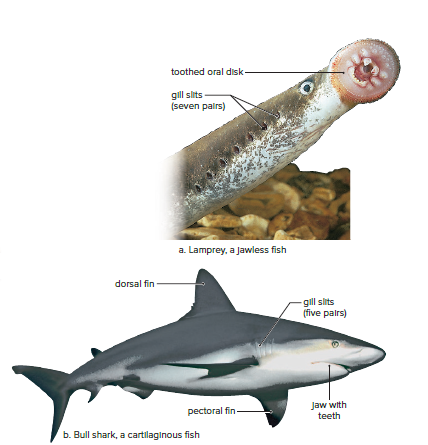
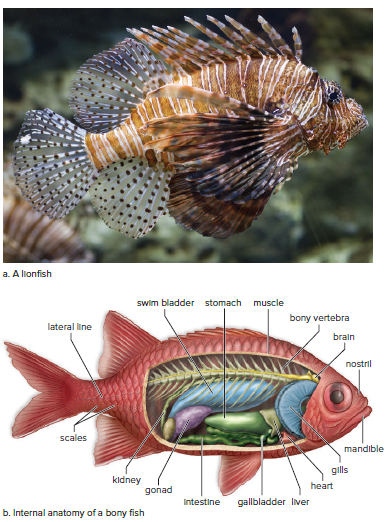
Amphibians: Jointed Vertebrate Limbs
The first chordates to make their way to the land environment were the amphibians.
Amphibians live both on land and in the water.
Amphibians are represented today by frogs, toads, newts, and salamanders.
Amphibians have various colors, some of which have skin toxins that sicken or kill predators.
Amphibians have jointed limbs, eyelids, a sound-producing larynx, and ears adapted to picking up sound waves.
Adult amphibians usually have small lungs and respiration is supplemented by gas exchange through the smooth, moist, glandular skin.
The amphibian heart has only three chambers, compared with four in mammals.
Most members of this group lead an amphibious life.
Some amphibians do not demonstrate metamorphosis.
A great variety of reproductive strategies are seen among amphibians.
Water pollution and human-made chemicals have caused a drastic reduction in amphibian populations worldwide.
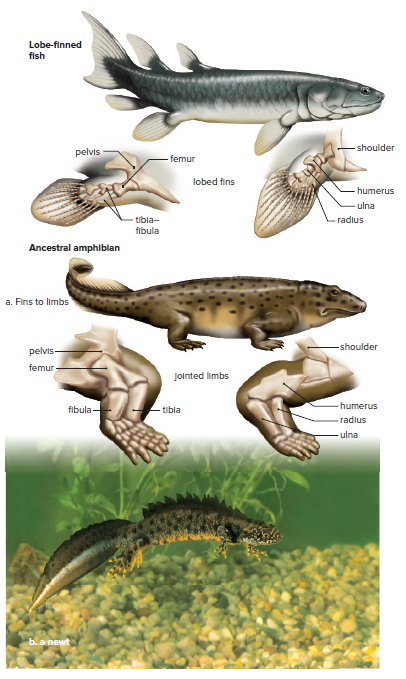
Reptiles: Amniotic Egg
Reptiles diversified and were most abundant between 245 and 66 MYA.
Dinosaurs were a type of reptile known for their great size.
Brachiosaurus was an herbivore and was about 23 m (75 feet) long and 17 m (56 feet) tall.
Tyrannosaurus rex was a carnivore and was 5 m (16 feet) tall when standing on its hind legs.
The bipedal stance of some reptiles was preadaptive for the evolution of wings in birds.
Reptiles living today include turtles, crocodiles, snakes, lizards, and birds.
The typical reptilian body is covered with hard, keratinized scales.
Reptiles have well-developed lungs enclosed by a protective rib cage.
Most reptiles have a three-chambered heart.
Reptiles have a means of reproduction suitable to a land existence.
Fertilization is internal, and the female lays leathery, flexible, shelled eggs.
The amniotic egg made development on land possible and eliminated the need for a water environment during development.
Fishes, amphibians, and reptiles (other than birds) are ectothermic.
Most reptiles regulate their body temperature by exposing themselves to the sun if they need warmth and hiding in the shadows if they need cooling off.
Feathered Reptiles: Birds
Birds share a common ancestor with crocodiles and have reptilian traits.
Birds lay hard-shelled amniotic eggs.
Recent discoveries of fossils of feathered reptiles indicate that birds are closely related to bipedal dinosaurs.
Nearly every anatomical feature of a bird can be related to its ability to fly.
Birds have a four-chambered heart that completely separates O2-rich blood from O2-poor blood.
Birds are endothermic and generate internal heat.
Birds have no bladder and excrete uric acid in a semi-dry state.
Birds have particularly acute vision and well-developed brains.
Birds navigate by using the sun, stars, and the Earth’s magnetic field to guide them.
The classification of birds was traditionally based on beak and foot types and habitat and behavior.
Genetic data are now used to determine relationships among birds.
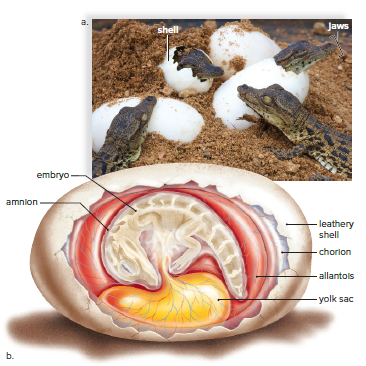
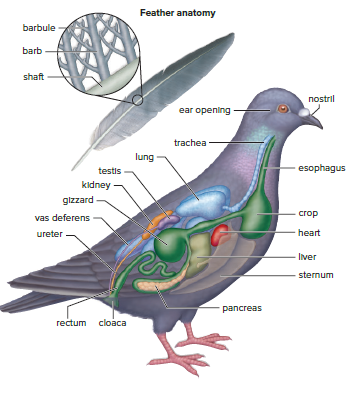

Mammals: Hair and Mammary Glands
Mammals are amniotes and share a common ancestor with reptiles.
Mammals represent a separate evolutionary lineage from the reptile lineage that led to birds.
First, mammals evolved during the Triassic period and were small.
Mammals changed little during the Triassic and Jurassic periods due to the dominance of dinosaurs.
Monotremes and marsupials represent some of the earliest mammalian groups.
Placental mammals are the most abundant and can be found in most environments.
Two chief characteristics of mammals are hair and milk-producing mammary glands.
Almost all mammals are endotherms and generate internal heat.
Hair provides insulation against heat loss and allows mammals to be active in cold weather.
Mammary glands enable females to nurse their young without leaving them to find food.
Monotremes are mammals that have a cloaca and lay hard-shelled amniotic eggs.
Monotremes are represented by the spiny anteater and the duckbill platypus.
Female duckbill platypus lays eggs in a burrow and incubates them.
Spiny anteater has a pouch on the belly side formed by swollen mammary glands and longitudinal muscle.
Young remain in the pouch for about 53 days and then stay in a burrow where the mother periodically visits and nurses them.
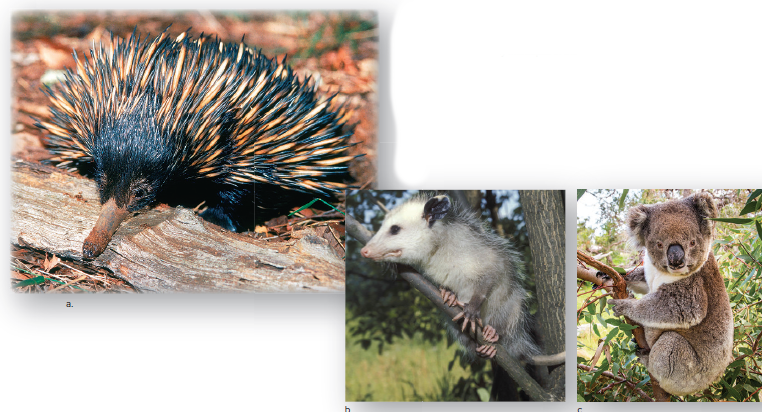
Marsupial young develop inside the female's body but are born in an immature condition.
Newborns crawl up into a pouch on their mother's abdomen and attach to the nipples of mammary glands.
More young are born than can be accommodated by the number of nipples.
Virginia opossum is the only marsupial north of Mexico.
Marsupials are mainly found in Australia, with some in Central and South America.
Koalas are tree-climbing browsers, and kangaroos are grazers.
The Tasmanian wolf or tiger is extinct and was a carnivorous marsupial.
Placental mammals have extraembryonic membranes modified for internal development within the uterus.
Nutrients, oxygen, and waste are exchanged between fetal and maternal blood in placental mammals.
Mammals have limbs that allow them to move rapidly, a well-developed brain, expanded lungs, and a four-chambered heart.
The mammalian brain is enlarged due to the expansion of the cerebral hemispheres.
Mammals learn to take care of themselves during a period of dependency on their parents.
Mammals can be distinguished by their method of obtaining food and their mode of locomotion.
Teeth shape, and size may be associated with whether the mammal is an herbivore, carnivore, or omnivore.
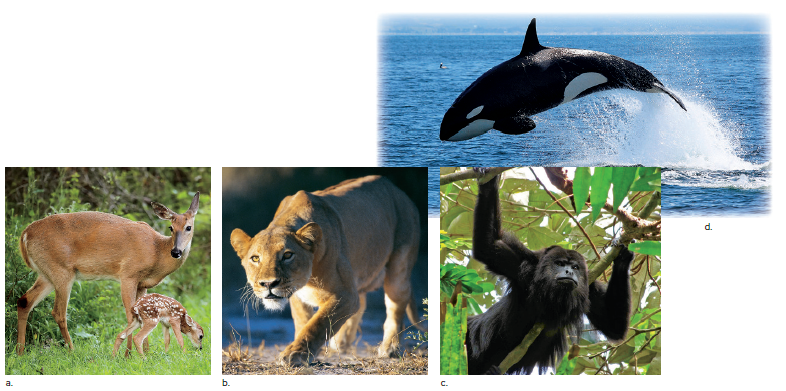
19.6 Human Evolution
All primates share one common ancestor, and other types of primates diverged from the human line of descent over time.
Prosimians include lemurs, tarsiers, and lorises.
Anthropoids include monkeys, apes, and humans.
Hominid includes African and Asian apes, chimpanzees, humans, and the closest extinct relatives of humans.
Hominin refers to our species, Homo sapiens, and our close humanlike ancestors.
Primate limbs are mobile, and the hands and feet have five digits each.
Many primates have both an opposable big toe and an opposable thumb.
The evolutionary trend among primates is generally toward a larger and more complex brain.
Humans and apes share a common, apelike ancestor.
Paleontologists use certain anatomical features when they try to determine if a fossil is a hominin.
These features include bipedalism, the shape of the face, and brain size.
Today’s humans have a flatter face and a more pronounced chin than do the apes.
Chimpanzees have a brain size of about 400 cubic centimeters (cc), and modern humans have a brain size of about 1,360 cc.
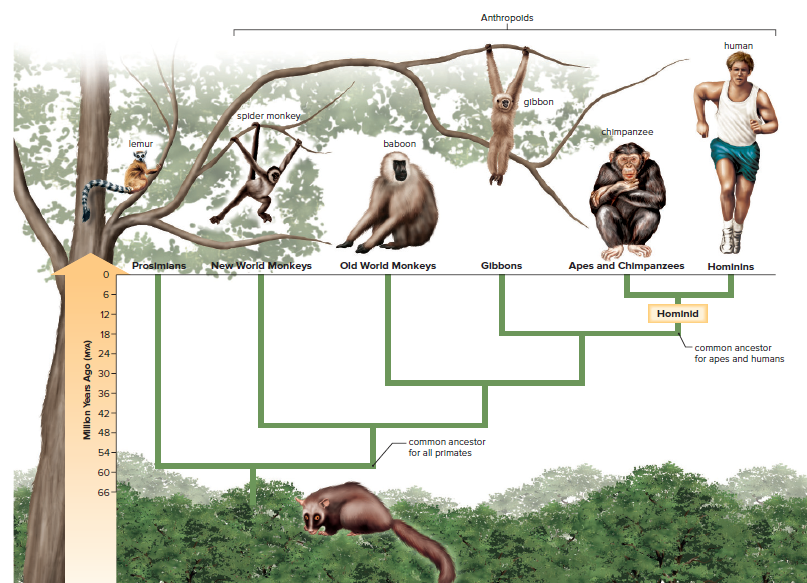
Evolution of Humanlike Hominins
The evolution of Homo has been studied extensively and there is evidence that some previously considered separate species are variations of a single species.
Recent discoveries of Homo neladi in Africa are challenging the dates and relationships between Homo species.
Early Humanlike Hominins
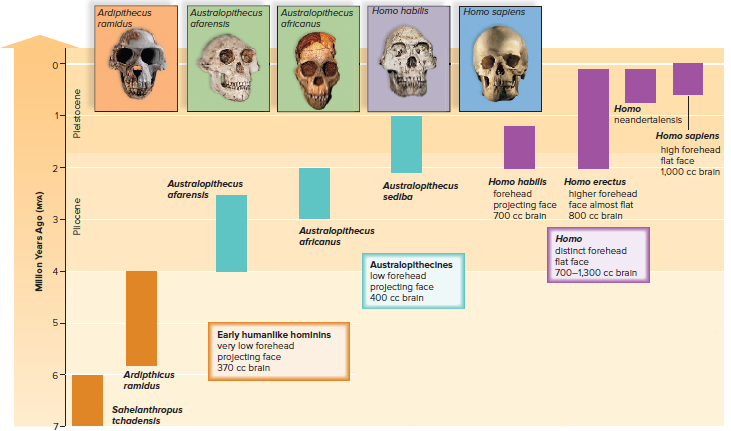
Figure 19.38 represents early hominins with orange-colored bars.
Sahelanthropus tchadensis is a fossil found around the time the ape lineage and the human lineage split.
Only the braincase of Sahelanthropus tchadensis has been found and dated at 7 MYA.
The braincase is apelike, but the location of the opening for the spine at the back of the skull suggests bipedalism.
The canines of Sahelanthropus tchadensis are smaller, and the tooth enamel is thicker than in an ape.
Ardipithecus ramidus is representative of the ardipithecines of 4.5 MYA.
The fossil remains of Ardipithecus ramidus are commonly called "Ardi."
Reconstructions of the fossils suggest that Ardipithecus ramidus was bipedal, and some individuals may have been 122 cm tall.
The teeth of Ardipithecus ramidus seem intermediate between those of earlier apes and those of later hominins.
Fossils dated at 4 MYA show a direct link between Ardipithecus ramidus and the australopithecines.
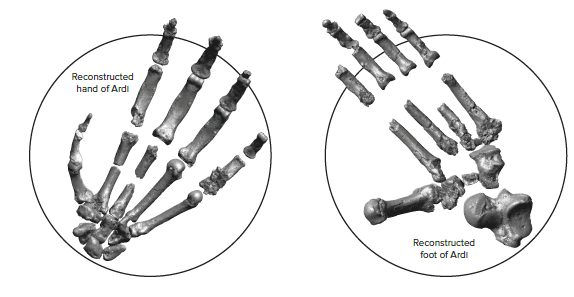
Australopithecines
One of the australopithecines may be a direct ancestor of humans.
Donald Johanson's team found nearly 250 fossils of Australopithecus afarensis over 20 years ago.
Lucy, a famous female skeleton, was dated to 3.18 MYA and had a small brain but walked upright.
Footprints dated about 3.7 MYA provide evidence of bipedal locomotion.
Australopithecus sediba shows that the transition to bipedalism occurred gradually over time.
Changes in the pelvis occurred at a different rate than those in the limbs.
A. sediba is apelike above the waist and humanlike below the waist, indicating mosaic evolution.
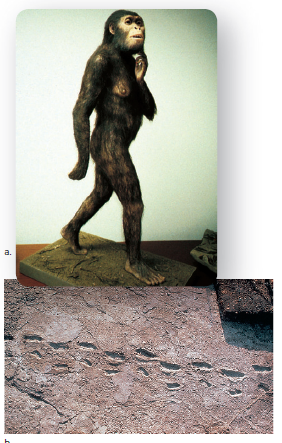
Homo Habills
Homo habilis lived between 2.4 and 1.4 MYA and may be ancestral to modern humans.
Some fossils of H. habilis have a brain size as large as 775 cc, which is about 45% larger than the brain of A. afarensis.
The cheek teeth of H. habilis are smaller than those of any of the australopithecines, suggesting that they were omnivorous and ate meat in addition to plant material.
Bones at the campsites of H. habilis bear cut marks, indicating that they used tools to strip the meat from bones. The tools consisted of sharp flakes of broken rocks.
The skulls of H. habilis suggest that the portions of the brain associated with speech areas were enlarged, which may have led to hunting cooperatively and the beginning of society and culture.
Culture is dependent on the capacity to speak and transmit knowledge, and the advantages that having a culture brought to H. habilis may have hastened the extinction of the australopithecines.
Homo Erectus
Fossils of Homo erectus have been found in Africa, Asia, and Europe and dated between 1.9 and 0.15 MYA.
H. erectus had a larger brain (about 1,000 cc) and a flatter face compared to H. habilis.
H. erectus was much taller than the earlier hominins. Males were 1.8 m tall, and females were 1.55 m.
H. erectus was most likely the first hominin to use fire and fashioned more advanced tools than earlier Homo species.
H. erectus used heavy, teardrop-shaped axes and cleavers, as well as stone flakes that were probably used for cutting and scraping.
H. erectus was a systematic hunter that took kills to the same site over and over again.
H. erectus was most likely erect and had a striding gait, like that of modern humans.
The size of the birth canal indicates that infants were born in an immature state that required an extended period of care.
H. erectus first appeared in Africa and then migrated to Asia and Europe.
H. erectus fossils in Java and the Republic of Georgia have been dated at 1.9 and 1.6 MYA, respectively.
H. erectus was a tribute to the intellectual and physical skills of the species.
Perhaps a language evolved and a culture more like our own developed.

Evolution of Modern Humans
The evolution of modern humans from early humanlike hominins is explained by the replacement model or out-of-Africa hypothesis.
The hypothesis suggests that modern humans evolved from archaic humans only in Africa and then migrated to Asia and Europe.
The archaic species were replaced by modern humans about 100,000 years BP.
New genomic information on the Neandertals and Denisovans is challenging this hypothesis.
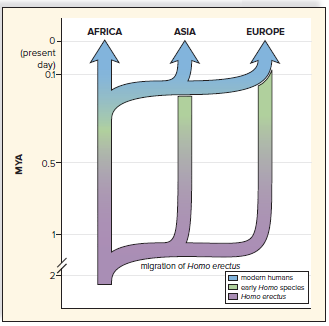
Neandertals
Neandertals (Homo neandertalensis) were named after Germany's Neander Valley, where the first Neandertal skeleton was discovered.
They had massive brow ridges, protruding nose, jaws, and teeth, low and sloping forehead, and lacked a chin.
Their pubic bone was longer than that of modern humans.
According to the replacement model, Neandertals were eventually supplanted by modern humans.
Studies of the Neandertal genome suggest that Neandertals interbred with Homo sapiens and that between 1% and 4% of the genomes of non-African H. sapiens contain remnants of the Neandertal genome.
Some scientists suggest that Neandertals were not a separate species but simply a race of H. sapiens that was eventually absorbed into the larger population.
The Neandertal brain was, on average, slightly larger than that of H. sapiens (1,400 cc compared with 1,360 cc in most modern humans).
The Neandertals were heavily muscled, especially in the shoulders and neck.
They lived in Europe and Asia during the last Ice Age, and their sturdy build could have helped their bodies conserve heat.
The Neandertals were culturally advanced, lived in caves, and manufactured a variety of stone tools, including spear points, scrapers, and knives.
They most likely successfully hunted bears, woolly mammoths, rhinoceroses, reindeer, and other contemporary animals.
They used and could control fire, which probably helped them cook meat and keep themselves warm.
They buried their dead with flowers and tools and may have had a religion.
Denisovans
In 2008, a finger bone fragment was found in Denisova cave in southern Siberia.
Initially, scientists thought it belonged to an early Homo species, possibly related to Homo erectus.
Mitochondrial DNA studies revealed that the fossil belonged to a species that existed around 1 MYA, around the same time as Neandertals.
The Denisovans and Neandertals had a common ancestor but did not interbreed with one another, possibly due to their geographic locations.
Homo sapiens in the Oceania region share around 5% of their genomes with the Denisovans.
An allele that allows for high-elevation living in Tibetans originated with the Denisovans.
Modern H. sapiens may have assimilated archaic humans by inbreeding rather than simply replacing them.
The implications of the Denisovan discovery are still being studied by scientists.
Cro-Magnons
Cro-Magnons are the oldest fossils designated as H. sapiens.
They are named after a location in France where their fossils were found.
They had a modern appearance and made advanced tools, including compound tools.
They may have been the first to make knifelike blades and throw spears.
They were skilled hunters and possibly responsible for the extinction of many larger mammals.
They hunted cooperatively and may have been the first to have a language.
They lived in small groups, with men hunting and women gathering and processing food.
Women were also engaged in maintenance tasks.
Cro-Magnon culture included art, such as small figurines and cave paintings of animals.
Chapter 19: The Animals
19.1 Evolution of Animals
The modern three-domain system places animals in:
Domain Eukarya
Kingdom Animalia
Within Eukarya, animals are placed in the supergroup Opisthokonta along with:
Fungi
Certain protists (notably the choanoflagellates)
Animals share important differences from other multicellular eukaryotes:
Unlike plants, animals are heterotrophs and must acquire nutrients from an external source.
Unlike fungi, animals ingest whole food and digest it internally.
Animals share the following characteristics:
Multicellular with specialized cells that form tissues and organs.
Possess nervous and muscular tissues that allow for mobility (locomotion).
Have a life cycle in which the adult is typically diploid.
Usually undergo sexual reproduction and produce an embryo that goes through developmental stages.
Heterotrophs that acquire food by ingestion, followed by digestion.

Ancestry of Animals

Plants and charophytes share a green algal ancestor.
Animals most likely evolved from a protozoan.
The colonial flagellate hypothesis suggests that animals descended from a hollow, spherical colony of flagellated cells.
Figure 19.2 shows the process of how this could have begun with a few flagellated cells forming an aggregate and then a larger number of cells forming a hollow sphere.
Individual cells within the colony would have become specialized for particular functions, such as reproduction.
Two tissue layers could have arisen by an infolding of certain cells into a hollow sphere.
Choanoflagellates most likely resemble the last single-celled ancestor of animals.
Molecular data tells us that choanoflagellates are the closest living protist relative of animals.
A choanoflagellate is a single cell, 3-10 μm in diameter, with a flagellum surrounded by a collar of 30-40 microvilli.

The Evolutionary Tree of Animals
The animal kingdom is divided into 35 phyla.
The majority of animals are invertebrates.
Invertebrates lack an internal skeleton of bone or cartilage.
Invertebrates evolved first and outnumber vertebrates.
The fossil record is sparse regarding the early evolution of animals due to simple invertebrates.
Systematists established the evolutionary history of animals based on molecular, developmental, and anatomical data.
Molecular comparisons establish evolutionary relationships.
DNA sequences of closely related organisms have more in common.
Advances in genomics and proteomics enhance the ability to distinguish between animal groups.

Evolutionary Trends
Animals differ in biological organization.
Sponges are multicellular but have no true tissues, classified as parazoans.
Cnidarians are eumetazoans with true tissues formed from two germ layers.
Other eumetazoans have three germ layers (ectoderm, mesoderm, endoderm).
Germ layers give rise to all other tissues and organs in an animal's body.
Animals differ in symmetry.
Sponges are asymmetrical.
Cnidarians have radial symmetry, while flatworms have bilateral symmetry.
Bilateral symmetry is accompanied by cephalization, localization of a brain, and specialized sensory organs at the anterior end of an animal.
Bilateral symmetry marked the evolution of animals that were able to exploit environmental resources in new ways through their more active lifestyles.
Animals are distinguished by the patterns of development as early embryo.
Protostomes have the blastopore become the mouth, while deuterostomes have it become the anus.


Molecular and developmental data suggest that protostomes are more closely related to each other than to deuterostomes.
Protostomes are divided into subgroups: lophotrochozoans and ecdysozoans.
Lophotrochozoans grow by adding mass to their existing body, while ecdysozoans grow by molting.
Some protostomes have no body cavity and are acoelomates, while others are coelomates.
Roundworms are pseudocoelomates, and their body cavity is incompletely lined by mesoderm.
In coelomate animals, mesentery supports the internal organs.
Animals can be nonsegmented or segmented.
Segmentation leads to the specialization of body parts.
19.2 Sponges and Cnidarians: The Early Animals
Sponges: Multicellularity
Sponges are aquatic, largely marine animals that vary greatly in size, shape, and color.
Sponges have a cellular level of organization and lack organized tissues.
Molecular data classify sponges as parazoans, which are located at the base of the evolutionary tree of animals.
The body wall of a sponge is lined internally with flagellated cells called collar cells or choanocytes.
The beating of the flagella produces water currents that flow through the pores into the central cavity and out through the osculum.
Sponges are sedentary filter feeders that filter their food from the water by means of a straining device.
Sponges can reproduce both asexually and sexually.
Some sponges have an endoskeleton composed of spicules, small, needle-shaped structures with one to six rays.
Most sponges have fibers of spongin, a modified form of collagen.
A bath sponge is the dried spongin skeleton from which all living tissue has been removed.

Cnidarians: True Tissues
Cnidarians are an ancient group of invertebrates with a rich fossil record.
They are radially symmetrical and capture their prey with a ring of tentacles that bear specialized stinging cells called cnidocytes.
Each cnidocyte has a capsule called a nematocyst, which contains a long, spirally coiled, hollow thread-like fiber.
Some nematocysts trap prey or predator, while others have spines that penetrate and inject paralyzing toxins before the prey is captured and drawn into the gastrovascular cavity.
Cnidarians have two germ layers during development (ectoderm and endoderm) and a tissue level of organization as adults.
They are classified as the first of the eumetazoans.
Two basic body forms are seen among cnidarians—the polyp and the medusa.
Cnidarians have been the source of medicines, particularly drugs that counter inflammation.
Coral reefs are comprised of cnidarians whose calcium exoskeletons serve as the foundation for the reef.
Corals form symbiotic relationships with photosynthetic protists called dinoflagellates.

19.3 Flatworms, Molluscs, and Annelids: The Lophotrochozoans
Flatworms, molluscs, and annelids belong to the group of protostomes called lophotrochozoans.
The name "lophotrochozoans" is derived from a tentacle-like feeding structure called a lophophore and a larval stage called a trochophore.
Molecular analyses support the hypothesis that all lophotrochozoans share a common evolutionary ancestor.
Lophotrochozoans increase their body mass gradually without molting.
Lophotrochozoans are distinct from other protostomes, such as arthropods and nematodes.
Flatworms: Bilateral Symmetry
Flatworms (phylum Platyhelminthes) have bilateral symmetry and three germ layers.
They are acoelomates, meaning they lack a body cavity.
Free-living flatworms, called planarians, have a ladder-like nervous system, cephalization, and three muscle layers.
Planarians capture food by wrapping themselves around the prey, entangling it in slime, and pinning it down. They have a three-branched gastrovascular cavity where digestion occurs.
Planarians are hermaphrodites and practice cross-fertilization.
Parasitic flatworms belong to two classes: tapeworms and flukes.
Tapeworms are endoparasites of various vertebrates, including humans. They have a scolex and a series of reproductive units called proglottids.
Flukes are all endoparasites of various vertebrates and have an oral sucker and at least one other sucker used for attachment to the host. They are usually named for the organ they inhabit.


Molluscs
Molluscs: Coelomate organisms with a complete digestive tract.
The body is composed of at least three distinct parts:
Visceral mass: soft-bodied portion containing internal organs.
Foot: strong, muscular portion used for locomotion.
Mantle: membranous or sometimes muscular covering that envelops but does not completely enclose the visceral mass.
Mantle cavity: space between the two folds of the mantle.
The mantle may secrete an exoskeleton called a shell.
Radula: an organ that bears many rows of teeth and is used to obtain food.
Gastropods: the foot is ventrally flattened, and the animal moves by muscle contractions that pass along the foot.
Cephalopods: the foot has evolved into tentacles about the head.
Bivalves: are called bivalves because of the two parts of their shells.
Molluscs have economic importance as a source of food and pearls.


Annelids: Segmented Worms
Annelids are segmented worms with a well-developed coelom.
The coelom functions as a hydrostatic skeleton to facilitate movement.
Annelids have a complete digestive tract with specialized parts.
Annelids have an extensive closed circulatory system.
The nervous system consists of a brain, ventral nerve cord, and ganglia.
The excretory system consists of nephridia.
Most annelids are polychaetes.
Polychaetes have many setae that help them anchor or move.
Clam worms are predators with a well-defined head region.
Other polychaetes are sedentary tube worms.
Oligochaetes have few setae and include earthworms.
Earthworms are scavengers that live in the soil.
Leeches have no setae but have the same body plan as other annelids.
Leeches are fluid feeders that can penetrate the surface of an animal and suck in fluids.
Leeches secrete hirudin, a powerful anticoagulant.


19.4 Roundworms and Arthropods: The Ecdysozoans
Ecdysozoans are invertebrate protostomes like lophotrochozoans.
They secrete a nonliving exoskeleton (cuticle) that must be shed for growth to proceed.
This process is called molting or ecdysis.
Ecdysozoans include roundworms (nematodes) and arthropods.
Roundworms: Pseudocoelomates
Roundworms (phylum Nematoda) are nonsegmented with a smooth outside body wall.
They possess a pseudocoelom that is incompletely lined with mesoderm, which supports muscle contraction and enhances flexibility.
The digestive tract is complete with both a mouth and an anus.
Roundworms are generally colorless, less than 5 cm long, and occur almost everywhere.
Many are free-living and feed on algae, fungi, microscopic animals, dead organisms, and plant juices, causing great agricultural damage.
Parasitic roundworms live anaerobically in every type of animal and many plants.
Several parasitic roundworms infect humans, including Ascaris lumbricoides, which produce over 200,000 eggs daily.
Trichinosis is a fairly serious human infection caused by the female trichina worm, which burrows into the wall of the host’s small intestine and deposits live larvae in the bloodstream that encyst skeletal muscles.
Elephantiasis is caused by a filarial worm that utilizes mosquitoes as a secondary host, and it can cause limbs to swell to an enormous size.
Pinworm and hookworm infections are more common in the United States, with hookworm being very debilitating as the worms attach to the intestinal wall and feed on blood.
Good hygiene, proper disposal of sewage, thorough cooking of meat, and regular deworming of pets usually protect people from parasitic roundworms.

Arthropods: Jointed Appendages
Arthropods are a diverse phylum with over 1 million discovered species.
Many more species of arthropods, mostly insects, are yet to be discovered.
The success of arthropods can be attributed to six characteristics:
Jointed appendages that have become adapted to different means of locomotion, food gathering, and reproduction.
A rigid but jointed exoskeleton composed primarily of chitin that serves many functions, including protection, prevention of desiccation, attachment for muscles, and locomotion.
Segmentation, where the repeating units of the body are called segments, each with a pair of jointed appendages.
A well-developed nervous system with a brain, a ventral nerve cord, and various types of sense organs.
A variety of respiratory organs, including gills for marine forms, book lungs or air tubes called tracheae for terrestrial forms, and an open circulatory system with the dorsal heart pumping blood into various sinuses throughout the body.
Metamorphosis, where many arthropods undergo a change in form and physiology as the larva becomes an adult, allowing the larva to have a different lifestyle than the adult.
Crustaceans are a group of arthropods that include marine animals such as barnacles, shrimps, lobsters, and crabs.
Freshwater crustaceans include crayfish, and terrestrial ones include sowbugs or pillbugs.
Crustacean anatomy is diverse, but the head usually has a pair of compound eyes and five pairs of appendages.
The first two pairs of appendages are antennae and antennules, which have sensory functions, while the other three pairs are mouthparts used in feeding.
Lobsters have five pairs of walking legs, with the first one being a pinching claw, and gills situated above the walking legs.
The head and thorax are fused into a cephalothorax, covered by a nonsegmented carapace, while the abdominal segments have swimmerets and a fan-shaped tail to propel the lobster backward.
Crustaceans play a vital role in the food chain, with krill being a major source of food for baleen whales, sea birds, and seals.
Arachnids are a group of arthropods that include spiders, scorpions, ticks, mites, and harvestmen.
Spiders have a narrow waist that separates the cephalothorax from the abdomen and inject venom into their prey before digesting it externally.
Scorpions are among the oldest terrestrial arthropods and are nocturnal, spending most of the day hidden under a log or rock.
Ticks and mites are parasites that feed on vertebrates, with ticks sometimes transmitting diseases such as Rocky Mountain spotted fever and Lyme disease.


Horseshoe crabs are grouped with arachnids because of their first pair of appendages.
Horseshoe crabs have pedipalps and four pairs of walking legs.
Horseshoe crabs are valuable in medical science for their blood cells extract.
Millipedes have two pairs of legs on most segments and are herbivorous.
Centipedes have a pair of appendages on almost every segment and are carnivorous.
Insects are the largest group of arthropods and are adapted to an active life on land.
Insects have a head, thorax, and abdomen, with sensory antennae, compound eyes, and mouthparts adapted to their way of life.
The study of insects is called entomology.
Some insects show remarkable behavior adaptations, such as the social systems of bees, ants, termites, and other colonial insects.



19.5 Echinoderms and Chordates: The Deuterostomes
Echinoderms
Echinoderms are invertebrate animals represented by sea stars and sea urchins.
Echinoderms are the animals most closely related to chordates, which include vertebrates such as humans.
Echinoderms are deuterostomes like chordates.
Echinoderms are often radially symmetrical, not bilaterally symmetrical.
The larva of an echinoderm is a free-swimming filter feeder with bilateral symmetry, but it metamorphoses into a radially symmetrical adult.
Adult echinoderms do not have a head, a brain, or a segmentation.
The nervous system of echinoderms consists of nerves in a ring around the mouth and extending outward radially.
Echinoderm locomotion depends on a water vascular system.
Echinoderms don't have complex respiratory, excretory, and circulatory systems.
Most echinoderms feed on organic matter in the sea or substratum, but sea stars prey upon crustaceans, molluscs, and other invertebrates.
Sea stars cause extensive economic loss because they consume oysters and clams before they can be harvested.
Echinoderms are important in many ways, such as being eaten by fishes and sea otters and being favored for embryological research by scientists.


Chordates
The four characteristics of a chordate are:
A dorsal supporting rod called a notochord is located just below the nerve cord towards the back.
A dorsal tubular nerve cord that contains a canal filled with fluid.
Pharyngeal pouches that become functioning gills in some chordates and are modified for various purposes in terrestrial vertebrates.
A postanal tail that extends beyond the anus.

The Invertebrates Chordates
In some invertebrate chordates, the notochord is not replaced by the vertebral column.
Tunicates are ocean floor-dwelling chordates that look like thick-walled, squat sacs due to their tunic.
Tunicates are also called sea squirts because they squirt water from one of their siphons when disturbed.
Tunicate larvae are bilaterally symmetrical and have four chordate characteristics.
Metamorphosis produces sessile adults with numerous cilia that move water into the pharynx and out numerous gill slits, the only chordate characteristic that remains in the adult.
Lancelets are small marine chordates that look like small, two-edged surgical knives.
Lancelets are found in shallow water along most coasts and feed on microscopic particles filtered out of the constant stream of water that enters the mouth and exits through the gill slits.
Lancelets retain the four chordate characteristics as adults and have segmented muscles and a dorsal tubular nerve cord with periodic branches.

Evolutionary Trends Among the Chordates

Figure 19.27 shows the evolutionary tree of chordates and the animal groups discussed in the chapter.
Each animal group has at least one main evolutionary trend that distinguishes it from the preceding group.
Tunicates and lancelets are invertebrate chordates without vertebrae.
Vertebrates include fishes, amphibians, reptiles (including birds), and mammals.
Vertebrates have four chordate characteristics during embryonic development.
The notochord is generally replaced by a vertebral column composed of individual vertebrae.
Intervertebral discs are remnants of the notochord and are compressible, cartilaginous pads between the vertebrae.
The vertebral column is part of the flexible but strong endoskeleton, which shows that vertebrates are segmented.
Fishes with an endoskeleton of cartilage and some bone in their scales were the first to have jaws.
Early bony fishes had lungs.
Amphibians were the first group to have jointed appendages and to invade land.
The typical life cycle of amphibians includes a larval stage that lives in the water.
Reptiles, birds, and mammals have a means of reproduction more suited to land.
During development, an amnion and other extraembryonic membranes are present.
These membranes carry out all the functions needed to support the embryo as it develops into a young offspring capable of feeding on its own.
Fishes: First Jaws and Lungs
The first vertebrates were jawless fishes that sucked up food from the ocean floor.
There are three living classes of fishes: jawless fishes, cartilaginous fishes, and bony fishes.
The last two groups have jaws, tooth-bearing bones of the head.
Jaws are believed to have evolved from the first pair of gill arches.
Living representatives of the jawless fishes are cylindrical and up to a meter long.
The two groups of living jawless fishes are hagfishes and lampreys.
Hagfishes are scavengers, feeding mainly on dead fish.
Lampreys are parasites that use their round mouth as a sucker to attach to another fish and tap into its circulatory system.
The cartilaginous fishes are the sharks, the rays, and the skates, which have skeletons of cartilage instead of bone.
Skates and rays are rather flat fishes that live partly buried in the sand and feed on mussels and clams.
Sharks and rays have three well-developed senses that enable them to detect their prey: the ability to sense electric currents in the water, a lateral line system, and a keen sense of smell.
Bony fishes are by far the most numerous and diverse of all the vertebrates.
Most of the bony fishes we eat, such as perch, trout, salmon, and haddock, are ray-finned fishes.
Ray-finned fishes have a swim bladder, which usually serves as a buoyancy organ.
The streamlined shape, fins, and muscle action of ray-finned fishes are all suited to locomotion in the water.
Ray-finned fishes have a single-circuit circulatory system.
Another type of bony fish is the lobe-finned fish, which gave rise to the amphibians.



Amphibians: Jointed Vertebrate Limbs
The first chordates to make their way to the land environment were the amphibians.
Amphibians live both on land and in the water.
Amphibians are represented today by frogs, toads, newts, and salamanders.
Amphibians have various colors, some of which have skin toxins that sicken or kill predators.
Amphibians have jointed limbs, eyelids, a sound-producing larynx, and ears adapted to picking up sound waves.
Adult amphibians usually have small lungs and respiration is supplemented by gas exchange through the smooth, moist, glandular skin.
The amphibian heart has only three chambers, compared with four in mammals.
Most members of this group lead an amphibious life.
Some amphibians do not demonstrate metamorphosis.
A great variety of reproductive strategies are seen among amphibians.
Water pollution and human-made chemicals have caused a drastic reduction in amphibian populations worldwide.

Reptiles: Amniotic Egg
Reptiles diversified and were most abundant between 245 and 66 MYA.
Dinosaurs were a type of reptile known for their great size.
Brachiosaurus was an herbivore and was about 23 m (75 feet) long and 17 m (56 feet) tall.
Tyrannosaurus rex was a carnivore and was 5 m (16 feet) tall when standing on its hind legs.
The bipedal stance of some reptiles was preadaptive for the evolution of wings in birds.
Reptiles living today include turtles, crocodiles, snakes, lizards, and birds.
The typical reptilian body is covered with hard, keratinized scales.
Reptiles have well-developed lungs enclosed by a protective rib cage.
Most reptiles have a three-chambered heart.
Reptiles have a means of reproduction suitable to a land existence.
Fertilization is internal, and the female lays leathery, flexible, shelled eggs.
The amniotic egg made development on land possible and eliminated the need for a water environment during development.
Fishes, amphibians, and reptiles (other than birds) are ectothermic.
Most reptiles regulate their body temperature by exposing themselves to the sun if they need warmth and hiding in the shadows if they need cooling off.
Feathered Reptiles: Birds
Birds share a common ancestor with crocodiles and have reptilian traits.
Birds lay hard-shelled amniotic eggs.
Recent discoveries of fossils of feathered reptiles indicate that birds are closely related to bipedal dinosaurs.
Nearly every anatomical feature of a bird can be related to its ability to fly.
Birds have a four-chambered heart that completely separates O2-rich blood from O2-poor blood.
Birds are endothermic and generate internal heat.
Birds have no bladder and excrete uric acid in a semi-dry state.
Birds have particularly acute vision and well-developed brains.
Birds navigate by using the sun, stars, and the Earth’s magnetic field to guide them.
The classification of birds was traditionally based on beak and foot types and habitat and behavior.
Genetic data are now used to determine relationships among birds.



Mammals: Hair and Mammary Glands
Mammals are amniotes and share a common ancestor with reptiles.
Mammals represent a separate evolutionary lineage from the reptile lineage that led to birds.
First, mammals evolved during the Triassic period and were small.
Mammals changed little during the Triassic and Jurassic periods due to the dominance of dinosaurs.
Monotremes and marsupials represent some of the earliest mammalian groups.
Placental mammals are the most abundant and can be found in most environments.
Two chief characteristics of mammals are hair and milk-producing mammary glands.
Almost all mammals are endotherms and generate internal heat.
Hair provides insulation against heat loss and allows mammals to be active in cold weather.
Mammary glands enable females to nurse their young without leaving them to find food.
Monotremes are mammals that have a cloaca and lay hard-shelled amniotic eggs.
Monotremes are represented by the spiny anteater and the duckbill platypus.
Female duckbill platypus lays eggs in a burrow and incubates them.
Spiny anteater has a pouch on the belly side formed by swollen mammary glands and longitudinal muscle.
Young remain in the pouch for about 53 days and then stay in a burrow where the mother periodically visits and nurses them.

Marsupial young develop inside the female's body but are born in an immature condition.
Newborns crawl up into a pouch on their mother's abdomen and attach to the nipples of mammary glands.
More young are born than can be accommodated by the number of nipples.
Virginia opossum is the only marsupial north of Mexico.
Marsupials are mainly found in Australia, with some in Central and South America.
Koalas are tree-climbing browsers, and kangaroos are grazers.
The Tasmanian wolf or tiger is extinct and was a carnivorous marsupial.
Placental mammals have extraembryonic membranes modified for internal development within the uterus.
Nutrients, oxygen, and waste are exchanged between fetal and maternal blood in placental mammals.
Mammals have limbs that allow them to move rapidly, a well-developed brain, expanded lungs, and a four-chambered heart.
The mammalian brain is enlarged due to the expansion of the cerebral hemispheres.
Mammals learn to take care of themselves during a period of dependency on their parents.
Mammals can be distinguished by their method of obtaining food and their mode of locomotion.
Teeth shape, and size may be associated with whether the mammal is an herbivore, carnivore, or omnivore.

19.6 Human Evolution
All primates share one common ancestor, and other types of primates diverged from the human line of descent over time.
Prosimians include lemurs, tarsiers, and lorises.
Anthropoids include monkeys, apes, and humans.
Hominid includes African and Asian apes, chimpanzees, humans, and the closest extinct relatives of humans.
Hominin refers to our species, Homo sapiens, and our close humanlike ancestors.
Primate limbs are mobile, and the hands and feet have five digits each.
Many primates have both an opposable big toe and an opposable thumb.
The evolutionary trend among primates is generally toward a larger and more complex brain.
Humans and apes share a common, apelike ancestor.
Paleontologists use certain anatomical features when they try to determine if a fossil is a hominin.
These features include bipedalism, the shape of the face, and brain size.
Today’s humans have a flatter face and a more pronounced chin than do the apes.
Chimpanzees have a brain size of about 400 cubic centimeters (cc), and modern humans have a brain size of about 1,360 cc.

Evolution of Humanlike Hominins
The evolution of Homo has been studied extensively and there is evidence that some previously considered separate species are variations of a single species.
Recent discoveries of Homo neladi in Africa are challenging the dates and relationships between Homo species.
Early Humanlike Hominins

Figure 19.38 represents early hominins with orange-colored bars.
Sahelanthropus tchadensis is a fossil found around the time the ape lineage and the human lineage split.
Only the braincase of Sahelanthropus tchadensis has been found and dated at 7 MYA.
The braincase is apelike, but the location of the opening for the spine at the back of the skull suggests bipedalism.
The canines of Sahelanthropus tchadensis are smaller, and the tooth enamel is thicker than in an ape.
Ardipithecus ramidus is representative of the ardipithecines of 4.5 MYA.
The fossil remains of Ardipithecus ramidus are commonly called "Ardi."
Reconstructions of the fossils suggest that Ardipithecus ramidus was bipedal, and some individuals may have been 122 cm tall.
The teeth of Ardipithecus ramidus seem intermediate between those of earlier apes and those of later hominins.
Fossils dated at 4 MYA show a direct link between Ardipithecus ramidus and the australopithecines.

Australopithecines
One of the australopithecines may be a direct ancestor of humans.
Donald Johanson's team found nearly 250 fossils of Australopithecus afarensis over 20 years ago.
Lucy, a famous female skeleton, was dated to 3.18 MYA and had a small brain but walked upright.
Footprints dated about 3.7 MYA provide evidence of bipedal locomotion.
Australopithecus sediba shows that the transition to bipedalism occurred gradually over time.
Changes in the pelvis occurred at a different rate than those in the limbs.
A. sediba is apelike above the waist and humanlike below the waist, indicating mosaic evolution.

Homo Habills
Homo habilis lived between 2.4 and 1.4 MYA and may be ancestral to modern humans.
Some fossils of H. habilis have a brain size as large as 775 cc, which is about 45% larger than the brain of A. afarensis.
The cheek teeth of H. habilis are smaller than those of any of the australopithecines, suggesting that they were omnivorous and ate meat in addition to plant material.
Bones at the campsites of H. habilis bear cut marks, indicating that they used tools to strip the meat from bones. The tools consisted of sharp flakes of broken rocks.
The skulls of H. habilis suggest that the portions of the brain associated with speech areas were enlarged, which may have led to hunting cooperatively and the beginning of society and culture.
Culture is dependent on the capacity to speak and transmit knowledge, and the advantages that having a culture brought to H. habilis may have hastened the extinction of the australopithecines.
Homo Erectus
Fossils of Homo erectus have been found in Africa, Asia, and Europe and dated between 1.9 and 0.15 MYA.
H. erectus had a larger brain (about 1,000 cc) and a flatter face compared to H. habilis.
H. erectus was much taller than the earlier hominins. Males were 1.8 m tall, and females were 1.55 m.
H. erectus was most likely the first hominin to use fire and fashioned more advanced tools than earlier Homo species.
H. erectus used heavy, teardrop-shaped axes and cleavers, as well as stone flakes that were probably used for cutting and scraping.
H. erectus was a systematic hunter that took kills to the same site over and over again.
H. erectus was most likely erect and had a striding gait, like that of modern humans.
The size of the birth canal indicates that infants were born in an immature state that required an extended period of care.
H. erectus first appeared in Africa and then migrated to Asia and Europe.
H. erectus fossils in Java and the Republic of Georgia have been dated at 1.9 and 1.6 MYA, respectively.
H. erectus was a tribute to the intellectual and physical skills of the species.
Perhaps a language evolved and a culture more like our own developed.

Evolution of Modern Humans
The evolution of modern humans from early humanlike hominins is explained by the replacement model or out-of-Africa hypothesis.
The hypothesis suggests that modern humans evolved from archaic humans only in Africa and then migrated to Asia and Europe.
The archaic species were replaced by modern humans about 100,000 years BP.
New genomic information on the Neandertals and Denisovans is challenging this hypothesis.

Neandertals
Neandertals (Homo neandertalensis) were named after Germany's Neander Valley, where the first Neandertal skeleton was discovered.
They had massive brow ridges, protruding nose, jaws, and teeth, low and sloping forehead, and lacked a chin.
Their pubic bone was longer than that of modern humans.
According to the replacement model, Neandertals were eventually supplanted by modern humans.
Studies of the Neandertal genome suggest that Neandertals interbred with Homo sapiens and that between 1% and 4% of the genomes of non-African H. sapiens contain remnants of the Neandertal genome.
Some scientists suggest that Neandertals were not a separate species but simply a race of H. sapiens that was eventually absorbed into the larger population.
The Neandertal brain was, on average, slightly larger than that of H. sapiens (1,400 cc compared with 1,360 cc in most modern humans).
The Neandertals were heavily muscled, especially in the shoulders and neck.
They lived in Europe and Asia during the last Ice Age, and their sturdy build could have helped their bodies conserve heat.
The Neandertals were culturally advanced, lived in caves, and manufactured a variety of stone tools, including spear points, scrapers, and knives.
They most likely successfully hunted bears, woolly mammoths, rhinoceroses, reindeer, and other contemporary animals.
They used and could control fire, which probably helped them cook meat and keep themselves warm.
They buried their dead with flowers and tools and may have had a religion.
Denisovans
In 2008, a finger bone fragment was found in Denisova cave in southern Siberia.
Initially, scientists thought it belonged to an early Homo species, possibly related to Homo erectus.
Mitochondrial DNA studies revealed that the fossil belonged to a species that existed around 1 MYA, around the same time as Neandertals.
The Denisovans and Neandertals had a common ancestor but did not interbreed with one another, possibly due to their geographic locations.
Homo sapiens in the Oceania region share around 5% of their genomes with the Denisovans.
An allele that allows for high-elevation living in Tibetans originated with the Denisovans.
Modern H. sapiens may have assimilated archaic humans by inbreeding rather than simply replacing them.
The implications of the Denisovan discovery are still being studied by scientists.
Cro-Magnons
Cro-Magnons are the oldest fossils designated as H. sapiens.
They are named after a location in France where their fossils were found.
They had a modern appearance and made advanced tools, including compound tools.
They may have been the first to make knifelike blades and throw spears.
They were skilled hunters and possibly responsible for the extinction of many larger mammals.
They hunted cooperatively and may have been the first to have a language.
They lived in small groups, with men hunting and women gathering and processing food.
Women were also engaged in maintenance tasks.
Cro-Magnon culture included art, such as small figurines and cave paintings of animals.
 Knowt
Knowt